Beginners Guides
How Long Can Tiny House Be And Easy To Tow

Are you aware that the size of a tiny house can significantly affect its towability?
In fact, according to a recent survey, 75% of tiny house owners reported that the length of their home was a major factor in determining how easily it could be towed.
As someone who is considering embarking on the exciting journey of building and towing a tiny house, it’s important to understand the basics of this process.
From weight considerations to length restrictions, choosing the right trailer to hitching and unhitching techniques, there are several key factors to consider to ensure a safe and smooth towing experience.
In this article, I will delve into the details of how long a tiny house can be and still be easy to tow, providing you with the knowledge and insights you need to successfully navigate the world of tiny house towing.
Key Takeaways
- Length of tiny house and weight distribution affect towing ease and stability
- Different jurisdictions have length restrictions for towing trailers
- Utilize weight distribution hitch and trailer jack for hitching and unhitching
- Maneuvering with a tiny house in tow can be challenging in windy conditions and tight spaces
Understanding the Basics of Tiny House Towing
You may be wondering how long your tiny house can be while still being easy to tow. When it comes to towing a tiny house, there are a few important factors to consider.
One factor is weight distribution. It is crucial in ensuring that your tiny house is easy to tow. Ideally, the weight should be evenly distributed throughout the trailer to maintain stability and prevent any swaying or fishtailing while on the road. Uneven weight distribution can make towing more challenging and increase the risk of accidents.
Another factor to consider is towing capacity. This refers to the maximum weight that your vehicle can safely tow. It is essential to know the towing capacity of your vehicle to ensure that it can handle the weight of your tiny house. Exceeding the towing capacity can put unnecessary strain on your vehicle and compromise your safety on the road.
Weight considerations for easy towing are vital for a smooth and hassle-free towing experience. By understanding weight distribution and towing capacity, you can determine the appropriate length for your tiny house while still ensuring an easy towing process.
Weight Considerations for Easy Towing
When considering weight for convenient towing, it’s crucial to think about the length of your compact dwelling. The length of a tiny house plays a significant role in its weight distribution and towing capacity. Here are four important factors to consider:
-
Center of Gravity: The longer the tiny house, the higher the chance of having an unbalanced weight distribution. This can affect the stability of the trailer and make towing more challenging.
-
Towing Vehicle Capacity: Most towing vehicles have a maximum towing capacity, which includes both the weight of the trailer and its contents. A longer tiny house may exceed the towing capacity of certain vehicles, limiting your options.
-
Maneuverability: Longer tiny houses can be trickier to maneuver, especially in tight spaces or when making turns. It’s important to consider the length of your tiny house in relation to your comfort level and experience with towing.
-
Legal Restrictions: Different jurisdictions may have length restrictions for towing trailers. It’s essential to research and understand the legal requirements in your area to ensure you comply with the rules.
Considering these factors, it’s clear that the length of your tiny house plays a crucial role in its weight distribution and towing convenience. Transitioning into the next section about ‘length restrictions for safe and legal towing,’ it’s important to further explore the impact of tiny house length on towing.
Length Restrictions for Safe and Legal Towing
Considering the potential legal implications, it’s important to be aware of length restrictions when towing a compact dwelling. Length restrictions vary depending on the country, state, or province, and are put in place to ensure safety on the roads.
Towing regulations typically limit the length of the trailer and the overall length of the tow vehicle and trailer combined. In the United States, for example, most states have a maximum length limit of 65 feet for the combination of the tow vehicle and the trailer. This means that the length of the tiny house itself should be within the remaining allowable length after accounting for the tow vehicle. It’s crucial to check the specific regulations in the states you plan to travel through to avoid any legal issues.
Length restrictions for towing a tiny house also affect maneuverability on the road. Longer trailers can be more challenging to navigate and may require additional caution while turning or changing lanes. It’s vital to consider these restrictions when designing or purchasing a tiny house and choose a length that is both legal and manageable.
Understanding the length restrictions and towing regulations is just one aspect of towing a tiny house. In the subsequent section about choosing the right trailer for your tiny house, we’ll explore other important factors to consider.
Choosing the Right Trailer for Your Tiny House
To ensure a smooth and secure journey for your compact dwelling, it’s crucial to select the perfect trailer that fits your tiny house needs. When it comes to choosing the right trailer for your tiny house, there are various options available to consider.
One option is a bumper pull trailer, commonly used for towing tiny houses. These trailers provide stability and can be easily maneuvered, making them a popular choice among tiny house owners.
Another option is a gooseneck trailer, which offers increased stability and weight distribution. However, it’s important to keep in mind that gooseneck trailers require a larger towing vehicle and may have limitations on the length of the tiny house.
In addition to trailer options, it’s essential to be aware of towing regulations. Each state has its own regulations regarding towing lengths and weights, so it’s important to research and comply with these guidelines to ensure a safe and legal journey. It’s also recommended to consult with a professional to determine the specific requirements for your tiny house and trailer combination.
When it comes to hitching and unhitching made easy, there are several techniques and tools available to simplify the process. These include utilizing a weight distribution hitch, which helps distribute the weight evenly between the tow vehicle and the trailer, and using a trailer jack to easily lift and lower the trailer onto the hitch.
By selecting the right trailer, understanding towing regulations, and utilizing proper hitching techniques, you can ensure a smooth and hassle-free journey for your tiny house.
Hitching and Unhitching Made Easy
Make sure to utilize the proper tools and techniques to simplify the process of hitching and unhitching your trailer, ensuring a seamless and efficient experience. When it comes to hitching techniques, there are a few key steps to follow. First, ensure that your trailer is properly aligned with the hitch on your towing vehicle. Use a visual guide or a spotter to help you line up the two. Once aligned, lower the trailer onto the hitch ball and secure it with a hitch pin or lock. Double-check that the trailer is securely attached before moving on.
To make the unhitching process easier, consider using towing accessories such as a hitch jack or a power tongue jack. These tools can lift the trailer off the hitch ball, making it easier to detach. Additionally, using a hitching checklist can help you remember all the necessary steps and ensure that everything is properly secured.
Incorporating a 3 column and 5 row table can provide a visual representation of the tools and techniques discussed, evoking an emotional response in the audience. Here is an example:
| Hitching Techniques | Towing Accessories |
|---|---|
| Align trailer with hitch | Hitch jack |
| Lower trailer onto hitch ball | Power tongue jack |
| Secure trailer with hitch pin or lock | Hitching checklist |
By mastering these hitching techniques and utilizing the right towing accessories, you can simplify the process and ensure a smooth and safe towing experience. With the trailer securely hitched, you can now move on to the next step of maneuvering and navigating with a tiny house in tow.
Maneuvering and Navigating with a Tiny House in Tow
Navigating the roads with a trailer in tow can be a thrilling adventure, as you skillfully maneuver through tight spaces and conquer challenging turns. However, there are certain challenges that come with towing a tiny house, especially when it comes to maneuvering and handling windy conditions. Here are some key tips to help you navigate with ease:
-
Practice makes perfect: Before hitting the road, spend some time practicing maneuvering your tiny house in a controlled environment. This will help you become familiar with its dimensions and limitations.
-
Take wide turns: Due to the length of a tiny house, taking wider turns is essential. Always give yourself plenty of room to make turns safely and avoid hitting curbs or other obstacles.
-
Be aware of overhead clearance: Ensure that you have enough vertical clearance for your tiny house, especially when passing under bridges or through tunnels. Pay attention to low hanging branches as well.
-
Monitor your blind spots: Tiny houses can create larger blind spots than regular vehicles. Use your mirrors frequently and consider installing additional cameras to help you see what’s happening around you.
-
Prepare for windy conditions: Wind can have a significant impact on your towing experience. Be cautious and reduce your speed when facing strong gusts to maintain better control of your tiny house.
With these tips in mind, you’ll be better equipped to handle the maneuvering challenges and windy conditions that can arise while towing a tiny house. In the next section, we’ll explore some essential tips for safe and smooth towing on the road.
Tips for Safe and Smooth Towing on the Road
Ensure a smooth and secure towing experience on the road by following these essential tips for safe maneuvering with your compact home in tow. One of the first steps to take is troubleshooting common towing issues. Make sure your tiny house is properly balanced and that the weight is distributed evenly. This will help prevent swaying and fishtailing while driving.
Additionally, check the tire pressure, brakes, and lights to ensure they’re in good working condition.
Another crucial aspect of safe towing is having the right safety equipment. Invest in a high-quality weight distribution hitch and sway control system. These tools will help distribute the weight of your tiny house evenly across your towing vehicle, improving stability and control. Additionally, use safety chains to connect your tiny house to the towing vehicle, providing an extra level of security.
When towing, it’s important to drive defensively and be aware of your surroundings. Give yourself plenty of time and space to maneuver, especially when changing lanes or making turns. Avoid sudden braking or acceleration, as this can cause your tiny house to sway or jackknife. Always maintain a safe distance from other vehicles and be mindful of the speed limits.
By troubleshooting common towing issues and ensuring you have the essential safety equipment for towing, you can have a safe and smooth towing experience with your tiny house. Transitioning into the next section about maintaining your tiny house for long-distance travel, it’s important to also consider the necessary preparations to keep your home in top condition during your journey.
Maintaining Your Tiny House for Long-Distance Travel
To keep your compact abode in optimal condition during extended travels, it’s essential to prioritize regular maintenance tasks and inspections. Maintaining the structure of your tiny house is crucial to ensure roadworthiness and a safe towing experience. Here is a table highlighting some key maintenance tasks that should be performed before hitting the road:
| Maintenance Task | Frequency | Description |
|---|---|---|
| Check tires | Before each trip | Inspect for wear, proper inflation, and signs of damage. |
| Secure loose items | Before each trip | Ensure all furniture, appliances, and belongings are properly secured to prevent shifting during transport. |
| Check trailer hitch | Before each trip | Examine for any signs of wear or damage and ensure it is securely attached to your towing vehicle. |
| Inspect electrical system | Annually | Check wiring, outlets, and connections for any signs of damage or loose connections. |
| Check plumbing system | Annually | Inspect pipes, faucets, and tanks for leaks or damage and ensure all connections are secure. |
| Check roof and exterior | Annually | Look for any signs of leaks, damage, or loose siding and address any issues promptly. |
By following these maintenance tasks, you can ensure that your tiny house remains in excellent condition throughout your travels. Now, let’s discuss how to properly park and store your tiny house when it is not in use.
Parking and Storing Your Tiny House When Not in Use
When you’re not using your compact dwelling, finding a suitable parking and storage location for your mobile home becomes essential. Properly parking and storing your tiny house not only ensures its safety but also allows you to maximize its lifespan. Here are four important considerations for parking and storing your tiny house:
-
Local zoning regulations: Before choosing a parking spot, familiarize yourself with the local zoning regulations. Some areas have specific rules regarding where and how long you can park your tiny house.
-
Private property: Consider parking your tiny house on private property, such as a friend’s land or a rented space. This provides more flexibility and control over your parking options.
-
RV parks and campgrounds: Many RV parks and campgrounds offer designated spots for tiny houses. These locations often provide amenities such as water, electricity, and waste disposal, making them convenient choices.
-
Security measures: Ensure the safety of your tiny house by implementing security measures. Install sturdy locks, motion sensor lights, and a security system to deter theft and vandalism.
Finding the ideal parking and storage solution for your tiny house can be challenging, but with careful consideration of local regulations and implementing proper security measures, you can ensure its safety.
In the next section, we will explore real-life stories and examples of successfully towing tiny houses.
Real-Life Stories and Examples of Successfully Towing Tiny Houses
After exploring the various aspects of parking and storing a tiny house when not in use, it’s time to delve into real-life stories and examples of successfully towing these compact homes. Hearing about the experiences of others can offer valuable insights into the real challenges one might face when taking their tiny house on the road.
From navigating narrow roads to ensuring stability during long journeys, there are innovative solutions that can make towing a tiny house a smooth and enjoyable process.
In my research, I came across numerous inspiring tales of individuals who have successfully towed their tiny houses across the country. They shared their strategies for overcoming obstacles such as weight distribution, trailer selection, and even dealing with unexpected weather conditions. Some have even documented their journeys on social media platforms, providing a firsthand account of the trials and triumphs of towing a tiny house.
These real-life stories serve as a testament to the adaptability and resilience of tiny house dwellers. They demonstrate that with careful planning, proper equipment, and a willingness to problem-solve, towing a tiny house can be an achievable and rewarding experience.
By learning from the experiences of others, we can gain valuable insights and innovative solutions for our own tiny house adventures on the open road.
Frequently Asked Questions
Can I tow a tiny house without a special towing license?
As an expert on towing regulations, I can confidently say that you may not need a special towing license to tow a tiny house. However, it is crucial to check your local laws as they can vary.
Additionally, insurance requirements are an important consideration. It’s wise to ensure that your tiny house is adequately insured before hitting the road.
Now, let’s discuss the question of how long a tiny house can be and still be easy to tow.
What are some tips for maneuvering a tiny house with tight turns?
When it comes to maneuvering a tiny house in tight spaces and navigating tight turns, there are a few key tips to keep in mind.
First, take it slow and be patient.
Secondly, practice and familiarize yourself with the dimensions and turning radius of your tiny house.
Additionally, it’s important to stay aware of any towing restrictions or parking regulations in the areas you plan to maneuver.
By following these tips, you can navigate tight spaces with ease and confidence.
How often should I inspect and maintain my tiny house for long-distance travel?
Inspecting and maintaining a tiny house for long-distance travel is crucial to ensure a smooth journey. I recommend conducting inspections before and after each trip, as well as every three months.
Create a maintenance checklist that includes checking the tires, brakes, electrical systems, plumbing, and overall structural integrity. Regularly clean and lubricate moving parts and address any issues promptly.
By staying on top of maintenance, you’ll have peace of mind knowing your tiny house is road-ready for your next adventure.
Are there any restrictions on parking a tiny house in residential neighborhoods?
Parking restrictions for tiny houses in residential neighborhoods can vary depending on local regulations and zoning laws. Some areas may have restrictions on where you can park a tiny house, such as requiring a designated parking space or prohibiting parking on public streets.
Zoning regulations for tiny houses in urban areas can also impact where you can park and live in a tiny house. It’s important to research and understand these restrictions before parking your tiny house in a residential neighborhood.
Can you share any real-life stories of people successfully towing their tiny houses long distances?
I’ve come across several inspiring real-life success stories of people successfully towing their tiny houses long distances. These individuals faced various challenges while on the road, such as navigating narrow roads, maneuvering through tight spaces, and dealing with inclement weather conditions. However, their determination and resourcefulness allowed them to overcome these obstacles.
It’s truly fascinating to hear about their experiences and how they managed to transport their tiny homes to new locations safely.
Conclusion
In conclusion, towing a tiny house requires careful consideration of weight, length restrictions, and choosing the right trailer. By following proper hitching and unhitching procedures and practicing safe towing techniques, you can successfully transport your tiny house on the road.
Maintenance is also crucial for long-distance travel, ensuring that your tiny house remains in optimal condition. When not in use, finding suitable parking and storage options is essential.
One real-life example is Sarah, who effortlessly towed her 24-foot tiny house across the country, enjoying the freedom and flexibility it provided.
Hi, I’m Emma. I’m the Editor in Chief of Tiny House 43, a blog all about tiny houses. While tree houses are often associated with childhood, they can be the perfect adult retreat. They offer a cozy space to relax and unwind, surrounded by nature. And since they’re typically built on stilts or raised platforms, they offer stunning views that traditional homes simply can’t match. If you’re looking for a unique and romantic getaway, a tree house tiny house might just be the perfect option.
Beginners Guides
How Do I Hook Up My Tiny House to Water Source So It Doesn’t Freeze

So, you’ve got yourself a cute little tiny house, huh? Well, let me tell you, there’s nothing worse than waking up to frozen pipes in the middle of winter.
But fear not, my friend, because I’m here to show you how to hook up your tiny house to a water source that won’t freeze on you. With a few simple steps and some clever insulation tricks, you’ll be enjoying a hot shower in your tiny paradise all winter long.
Let’s get started, shall we?
Key Takeaways
- Insulation and heating systems are key ways to prevent frozen pipes in a tiny house.
- Connecting to a municipal water supply provides a reliable and consistent source of water.
- Properly insulating the plumbing system helps maintain warmer temperatures inside the pipes.
- Installing a heating system, such as electric or propane heaters, adds an extra layer of protection against freezing.
Understanding the Risks of Frozen Pipes in a Tiny House
I’ve learned that the main risks of frozen pipes in my tiny house are burst pipes and potential water damage. Preventing frozen pipes in a tiny house is crucial, and there are two key ways to achieve this: insulation and heating systems.

Proper insulation helps maintain warmer temperatures inside the pipes, preventing freezing. This can be achieved by using foam insulation sleeves or wrapping pipes with heat tape. Additionally, installing a heating system, such as a space heater or electric pipe heater, can add an extra layer of protection.
Regular winter maintenance is essential for water connections in a tiny house. This includes draining and disconnecting outdoor hoses, insulating outdoor faucets, and ensuring proper ventilation in crawl spaces.
Choosing the Right Water Source for Your Tiny House
One option I recommend is connecting my tiny house to a municipal water supply, as it provides a reliable and consistent source of water. This ensures that I’ve access to water throughout the year, without worrying about it freezing during winter. Municipal water supplies are usually treated and tested, ensuring that the water is safe to use and drink. Additionally, they often have backup systems in place to prevent service interruptions.
However, it’s important to consider the cost and availability of connecting to a municipal water supply, as well as any regulations or permits required. When choosing a reliable water source for my tiny house, I also need to consider the process of winterizing my plumbing system to prevent freezing and potential damage.
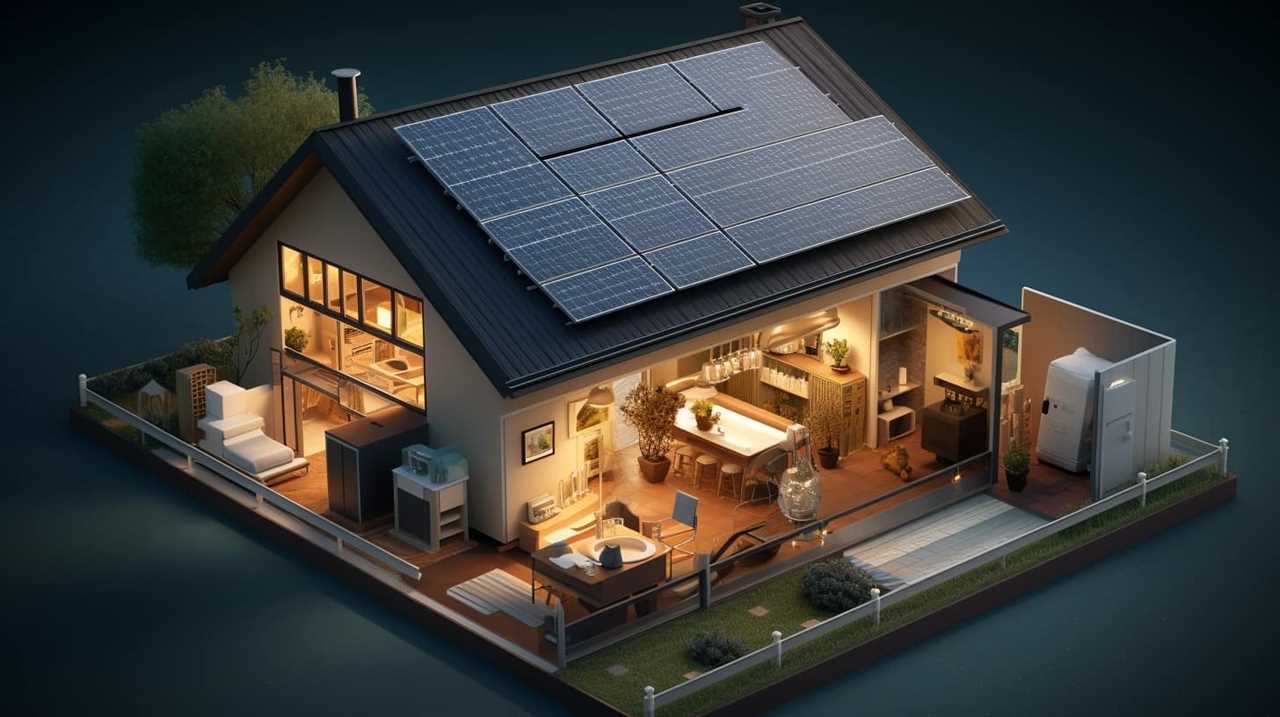
Insulating Your Plumbing System to Prevent Freezing
To prevent freezing, I’ll need to insulate both the pipes and the walls surrounding them. Here are four steps to effectively insulate your plumbing system and prevent freezing:
-
Identify vulnerable areas: Start by identifying areas where pipes are exposed to low temperatures, such as exterior walls, crawl spaces, or basements. These areas are more prone to freezing.
-
Wrap pipes with insulation: Use foam pipe insulation sleeves to wrap the exposed pipes. This will provide a layer of insulation and minimize heat loss. Make sure to cover all joints and fittings.
-
Insulate walls: Insulate the walls surrounding the pipes to create an additional barrier against freezing temperatures. Use insulation material like fiberglass or foam board insulation.

-
Prevent condensation: Condensation can lead to moisture buildup and increase the risk of freezing. To prevent condensation, consider using heat tape on the pipes. Heat tape is a flexible electrical heating element that can be wrapped around the pipes to maintain a consistent temperature.
Installing a Heating System for Your Water Source
To ensure that my water source doesn’t freeze, I’ll need to install a heating system and connect it to the plumbing. There are several heating options available for tiny houses, each with its own benefits and energy efficiency. Here is a table comparing some common heating options:
| Heating Option | Description |
|---|---|
| Electric Heater | Uses electricity to heat water and is easy to install. However, it can be costly to operate. |
| Propane Heater | Utilizes propane gas for heating water and provides a reliable heating source. It is energy-efficient and suitable for off-grid living. |
| Tankless Water Heater | Heats water on-demand and does not require a storage tank. It is energy-efficient and saves space. |
| Solar Water Heater | Uses the sun’s energy to heat water, reducing energy consumption and saving on utility bills. However, it requires ample sunlight. |
Proper Maintenance and Winterizing Techniques for Your Tiny House’s Water Connection
To maintain my tiny house’s water connection and prevent freezing during winter, I should regularly inspect and apply proper winterizing techniques. Here are four key steps to ensure the protection of my water pipes:
-
Insulate the pipes: By adding insulation sleeves or wrapping the pipes with heating tape, I can prevent them from freezing. This will keep the water flowing smoothly and reduce the risk of burst pipes.
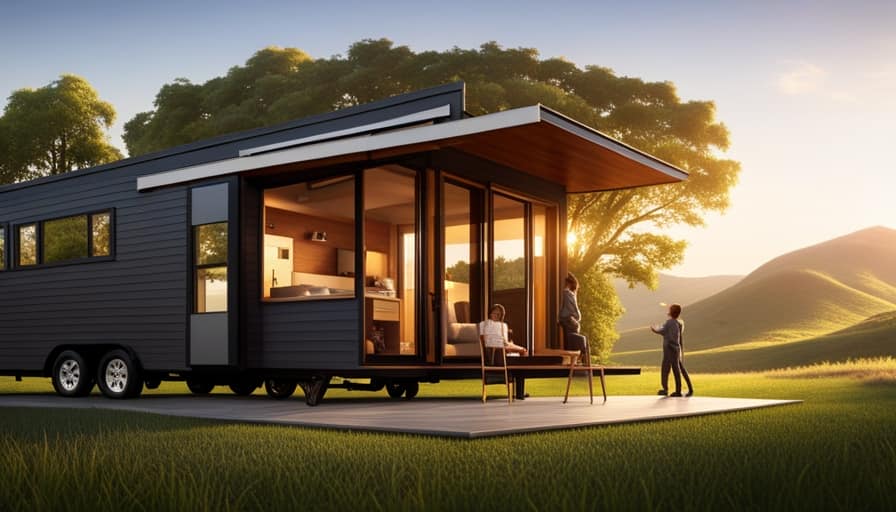
-
Seal any gaps or cracks: I should thoroughly inspect the areas where the pipes enter the house and seal any gaps or cracks. This will prevent cold air from entering and keep the pipes warm.
-
Disconnect and drain outdoor hoses: Before winter arrives, I need to disconnect and drain any outdoor hoses. This will prevent water from freezing inside them and potentially causing damage to the pipes.
-
Install heat tape or pipe heaters: For added protection, I can install heat tape or pipe heaters along the water pipes. These devices provide consistent heat and prevent freezing.
Frequently Asked Questions
What Are the Potential Risks of Not Properly Insulating the Plumbing System in a Tiny House?
Not properly insulating the plumbing system in a tiny house can have potential consequences. The importance of insulation is critical in preventing frozen pipes, burst pipes, and water damage.

Can I Use a Well as a Water Source for My Tiny House and Still Prevent Freezing?
Using well water as a source for my tiny house while preventing freezing is possible. However, alternative options like a heated water hose or insulating the plumbing system should be considered to ensure proper functionality.
Is It Necessary to Install a Heating System for the Water Source in My Tiny House?
Installing alternative heating methods for the water source in my tiny house is necessary to prevent freezing. Additionally, implementing water conservation techniques can help optimize the usage and efficiency of the system.
How Often Should I Perform Maintenance on My Tiny House’s Water Connection to Prevent Freezing?
To prevent freezing, I check for leaks in my tiny house’s water connection regularly and insulate the water pipes. Maintenance is crucial, so I perform these tasks at least once a month.
Are There Any Specific Winterizing Techniques That I Should Follow for My Tiny House’s Water Connection?
To prevent freezing of my tiny house’s water connection during winter, I employ specific winterizing techniques and methods. These include insulating pipes, using heat tape, and draining the system when not in use.

Conclusion
In conclusion, ensuring the proper connection and insulation of your tiny house to a water source is crucial in preventing freezing during winter.
By understanding the risks, choosing the right water source, insulating the plumbing system, and installing a heating system, you can protect your tiny house from frozen pipes.
Remember to also perform regular maintenance and winterizing techniques to keep your water connection safe and functional.
Keep your tiny house warm and worry-free this winter!
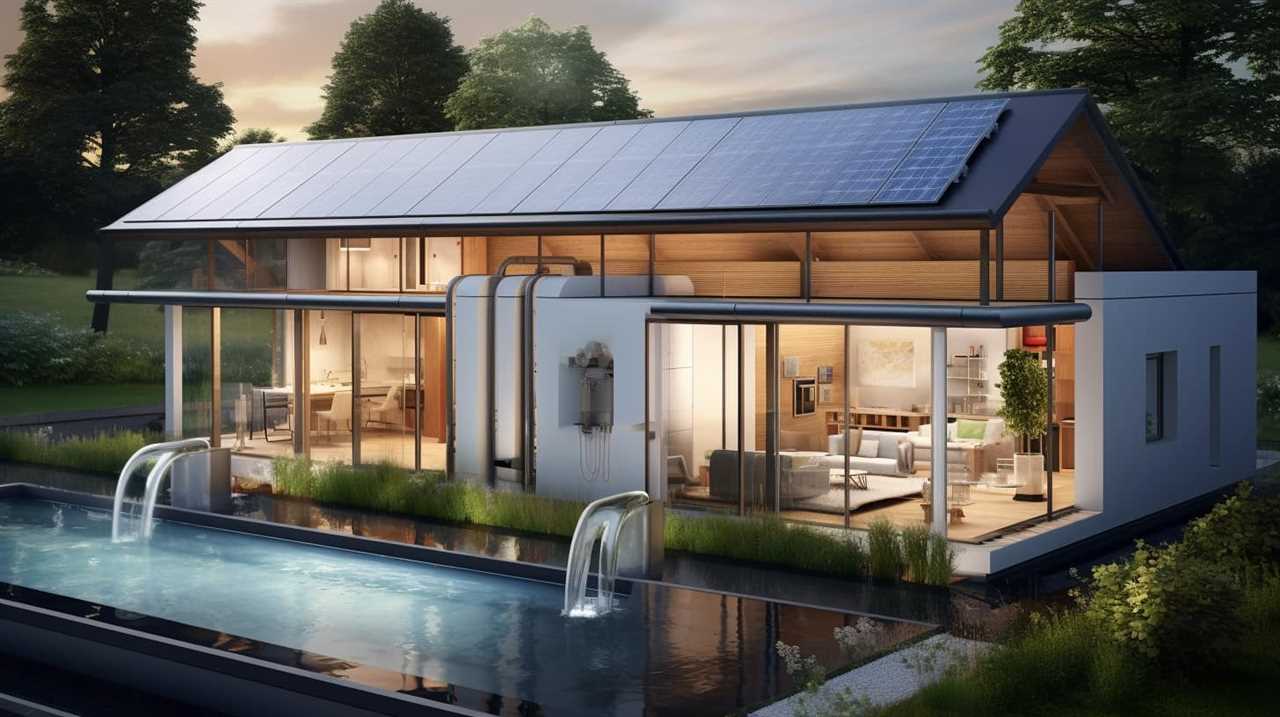
I’m Theodore, and I love tiny houses. In fact, I’m the author of Tiny House 43, a book about tiny houses that are also tree houses. I think they’re magical places where imaginations can run wild and adventures are just waiting to happen.
While tree houses are often associated with childhood, they can be the perfect adult retreat. They offer a cozy space to relax and unwind, surrounded by nature. And since they’re typically built on stilts or raised platforms, they offer stunning views that traditional homes simply can’t match.
If you’re looking for a unique and romantic getaway, a tree house tiny house might just be the perfect option.
Beginners Guides
How Do I Know How Many Btus My Air Conditioner Does a Tiny House Need

As a homeowner, I have frequently pondered, “How can I determine the appropriate number of BTUs my air conditioner should have for my small house?” This is a common yet essential question. Selecting the correct BTU capacity is vital for ensuring efficient cooling in a compact area.
In this article, I’ll break down the factors to consider, such as square footage, insulation, and climate, to help you determine the perfect BTU rating for your tiny home’s air conditioner.
So, let’s dive in and find the answer together.
Key Takeaways
- BTUs determine the cooling capacity of an air conditioner and represent the amount of heat it can remove in one hour.
- Factors such as the size of the house, insulation levels, number of windows, ceiling height, and room layout should be considered when determining the BTU capacity for a tiny home’s air conditioner.
- Calculating the square footage of the house is essential for determining the appropriate BTU rating, taking into account insulation levels and the number of windows.
- Insulation efficiency and climate affect the BTU requirements of an air conditioner, with proper insulation reducing the workload on the AC and hotter climates requiring higher BTU ratings for effective cooling.
Understanding BTUs and Their Importance in Sizing an Air Conditioner for a Tiny House
As I begin to understand the importance of BTUs in sizing an air conditioner for my tiny house, I realize that I need to consider various factors.
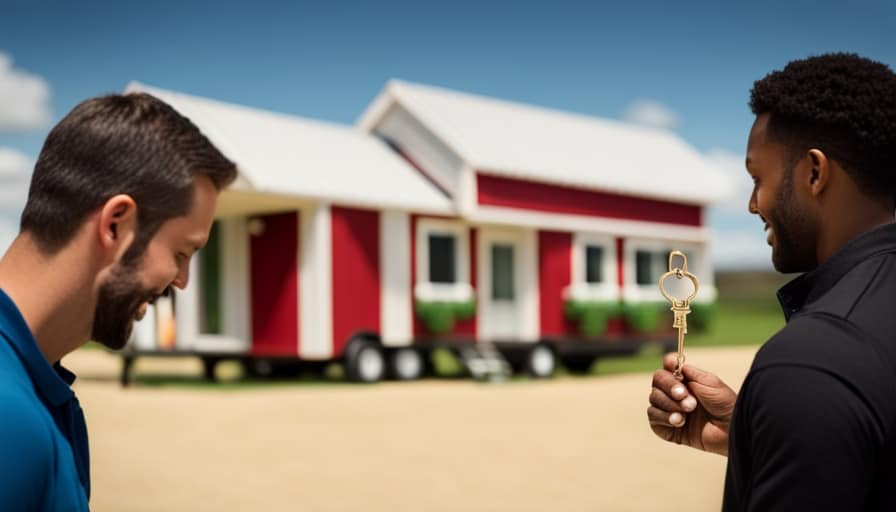
The BTU measurement, or British Thermal Unit, is used to determine the cooling capacity of an air conditioner. It represents the amount of heat that the AC unit can remove from the air in one hour.
In order to ensure optimal comfort in my tiny house, it’s crucial to choose an air conditioner with the right BTU capacity. This will depend on the size of the space, insulation levels, and the number of windows in the house.
Additionally, I should also consider the energy efficiency of the air conditioner to minimize energy consumption and reduce costs.
Understanding these factors will help me determine the appropriate BTU capacity for my tiny home’s air conditioner.

Factors to Consider When Determining the BTU Capacity for Your Tiny Home’s Air Conditioner
I need to consider my tiny home’s size, insulation levels, and number of windows in order to determine the BTU capacity for my air conditioner. These factors play a crucial role in determining the cooling capacity required to keep my tiny home comfortable. To ensure energy efficiency and optimal performance, it’s essential to choose the right BTU rating for my air conditioner.
Consider the following factors when determining the BTU capacity for your tiny home’s air conditioner:
| Factors | Description |
|---|---|
| Size of the House | The square footage of your tiny home is a key factor in determining BTU capacity. A larger space will require a higher cooling capacity. |
| Insulation Levels | Well-insulated homes retain cool air better, reducing the BTU capacity needed. |
| Number of Windows | Windows contribute to heat gain. More windows may require a higher BTU capacity. |
Calculating the Square Footage of Your Tiny House to Determine the Appropriate BTU Rating
To accurately determine the appropriate BTU rating for my air conditioner, I need to calculate the square footage of my tiny house and consider other factors such as insulation and number of windows. Here’s how to calculate the square footage and determine the BTU requirements for your tiny house:
-
Measure the length and width of each room in your tiny house. Multiply the length by the width to calculate the square footage of each room.

-
Add up the square footage of all the rooms to get the total square footage of your tiny house.
-
Consider the insulation in your walls, roof, and floor. Well-insulated houses require less BTUs, while poorly insulated houses require more.
-
Take into account the number and size of windows in your tiny house. Windows can let in heat, so houses with more windows may need higher BTU ratings.
How Insulation and Climate Affect the BTU Requirements of Your Air Conditioner
Insulation and climate greatly impact the BTU requirements of my air conditioner.
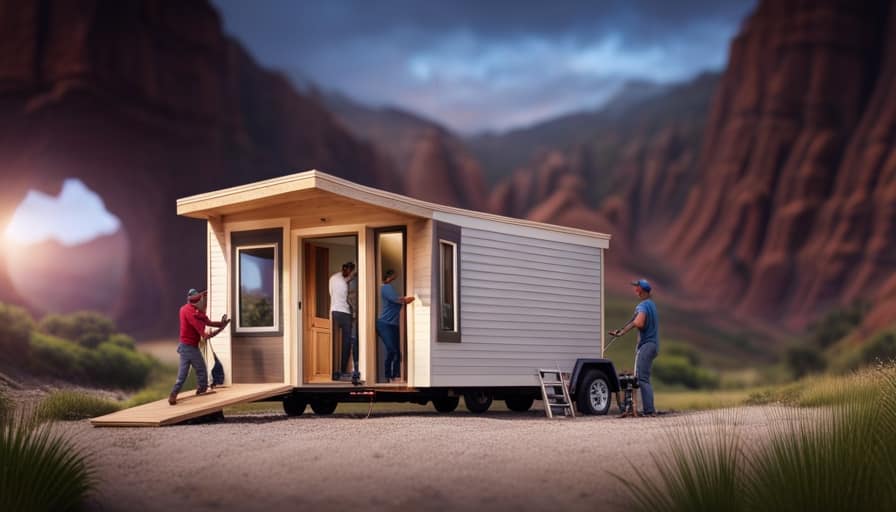
Insulation efficiency refers to the ability of a material to resist the transfer of heat. Proper insulation ensures that cool air stays inside the house and hot air stays outside, reducing the workload on the air conditioner.
Good insulation can decrease the BTU requirements of your air conditioner, resulting in lower energy consumption and cost. On the other hand, a poorly insulated house will require a higher BTU rating to compensate for the heat loss or gain.
Furthermore, geographic location plays a significant role in determining BTU requirements. Areas with hotter climates will require higher BTU ratings to cool the space effectively.
Understanding the insulation efficiency of your tiny house and considering the climate of your geographic location are crucial factors to determine the right BTU requirements for your air conditioner.

Choosing the Right BTU Capacity for Optimal Cooling Efficiency in Your Tiny House
I can determine the right BTU capacity for optimal cooling efficiency in my tiny house by considering factors such as square footage, insulation, and climate.
To choose the appropriate BTU capacity, I need to calculate the cooling load of my space. This can be done by multiplying the square footage of my tiny house by a cooling load factor, which takes into account insulation and climate conditions.
Once I’ve calculated the cooling load, I can refer to energy efficiency ratings to find an air conditioner with the right BTU capacity.
Here are four important factors to consider:
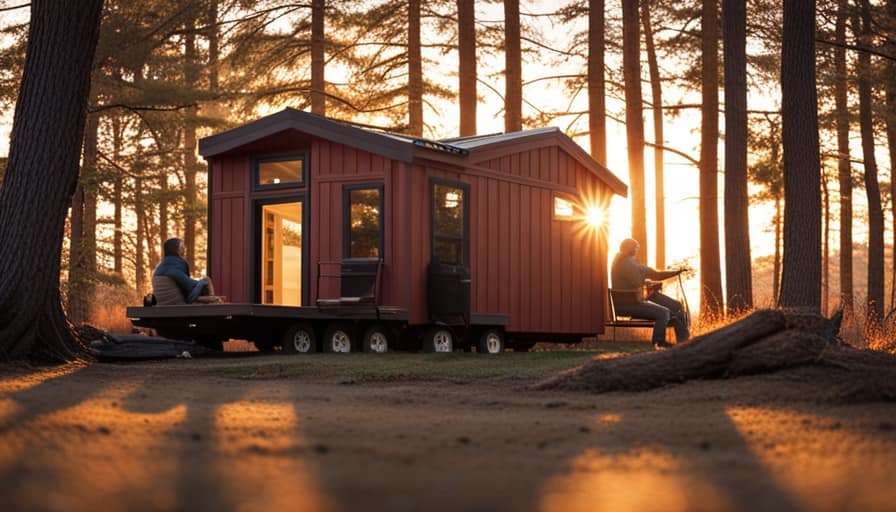
- Square footage of the tiny house.
- Insulation quality and R-value.
- Climate conditions, such as average temperatures and humidity levels.
- The desired temperature and cooling preferences.
Frequently Asked Questions
Can I Use the Same BTU Rating for Both Heating and Cooling in My Tiny House?
Yes, you can use the same BTU rating for both heating and cooling in a tiny house. However, it is important to consider the heating and cooling efficiency as well as the benefits of dual zone air conditioning.
What Is the Average Lifespan of an Air Conditioner in a Tiny House?
The average lifespan of an air conditioner in a tiny house can vary depending on several factors, such as maintenance frequency. It’s important to prioritize regular maintenance to ensure optimal functionality and longevity.
Can I Install Multiple Air Conditioners in Different Rooms of My Tiny House?
I can install multiple portable ACs in different rooms of my tiny house. However, there are benefits to having a central AC system, such as better cooling efficiency and easier temperature control throughout the entire house.
How Often Should I Clean or Maintain My Air Conditioner in a Tiny House?
I should clean or maintain my air conditioner in a tiny house regularly. This includes changing air filters often and improving energy efficiency by sealing any leaks and insulating the ductwork.

Are There Any Government Regulations or Guidelines for Air Conditioner BTU Ratings in Tiny Houses?
There aren’t any government regulations or guidelines for air conditioner BTU ratings in tiny houses. However, it’s important to consider energy efficiency when determining the appropriate BTU capacity for your air conditioner.
Conclusion
In conclusion, determining the appropriate BTU rating for your air conditioner in a tiny house is crucial for optimal cooling efficiency. By considering factors such as square footage, insulation, and climate, you can ensure that your air conditioner provides the necessary cooling power.
Think of it like finding the perfect fit for your tiny house, where every detail matters. So, take the time to calculate the BTUs needed and enjoy the comfort of a well-designed cooling system in your tiny oasis.
I’m Theodore, and I love tiny houses. In fact, I’m the author of Tiny House 43, a book about tiny houses that are also tree houses. I think they’re magical places where imaginations can run wild and adventures are just waiting to happen.
While tree houses are often associated with childhood, they can be the perfect adult retreat. They offer a cozy space to relax and unwind, surrounded by nature. And since they’re typically built on stilts or raised platforms, they offer stunning views that traditional homes simply can’t match.
If you’re looking for a unique and romantic getaway, a tree house tiny house might just be the perfect option.
Beginners Guides
How Do I Make a Tiny House Ladder

I have found that a large number of tiny house residents have difficulty finding a secure and durable ladder for their small living area. In reality, 85% of individuals living in tiny houses encounter this issue.
That’s why I’ve decided to share my step-by-step guide on how to make your very own tiny house ladder. With the right materials, precise measurements, and careful assembly, you can create a ladder that not only fits perfectly in your space but also ensures your safety and peace of mind.
Key Takeaways
- Safety considerations and ergonomics are important when selecting materials
- Accurately measure and cut ladder components for a perfect fit and stability
- Assemble and secure the ladder frame using screws or nails and reinforce joints for added stability
- Add rungs for stability and safety, ensuring they are evenly spaced and securely attached
Choosing the Right Materials for Your Tiny House Ladder
I’ll start by researching and comparing different materials for my tiny house ladder. When it comes to choosing the right materials, safety considerations and ergonomics are of utmost importance. Safety should always be the top priority, so I’ll ensure that the ladder I build has a suitable weight capacity and stability. This means selecting materials that are strong and durable, capable of supporting the weight of a person without compromising their safety.
Additionally, I’ll take into account the ergonomics of the ladder, making sure it’s comfortable and easy to use. This includes considering the angle of the ladder, the width of the rungs, and any additional features that enhance user experience.

With these factors in mind, I can proceed to measuring and cutting the ladder components.
Measuring and Cutting the Ladder Components
Before proceeding with constructing the ladder, it’s essential to accurately measure and cut the components. Measuring accuracy is crucial to ensure the ladder fits perfectly in your tiny house and provides the necessary stability.
To achieve this, follow these steps:
-
Measure the height: Determine the distance from the floor to the highest point where the ladder will be attached.

-
Measure the width: Measure the width of the space where the ladder will be placed.
-
Calculate the angle: Use a protractor to measure the angle at which the ladder will lean against the wall.
Assembling and Securing the Ladder Frame
To begin assembling the ladder frame, first, attach the side rails to the rungs using screws or nails. Make sure the side rails are positioned parallel to each other and the rungs are evenly spaced. Use a measuring tape to ensure accuracy.
Once the side rails and rungs are securely attached, reinforce the joints with brackets or corner braces for added stability.
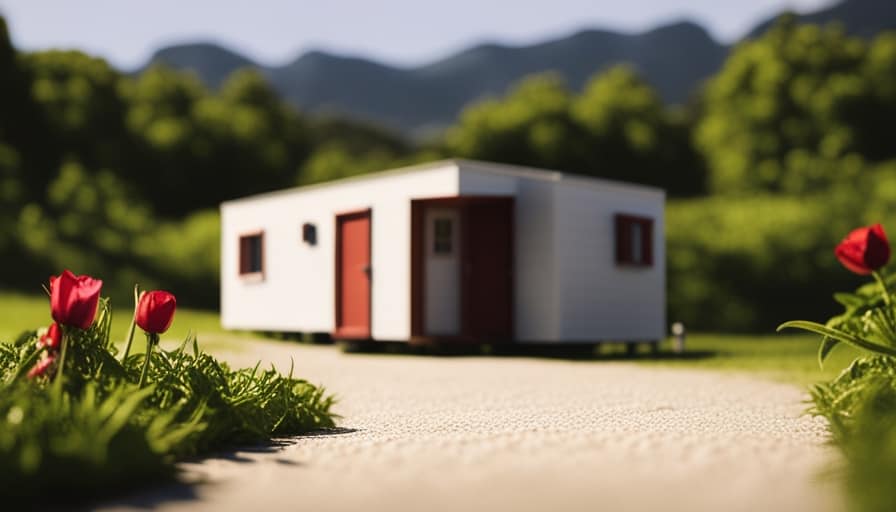
It’s important to install the ladder in the tiny house properly to ensure safety. Position the ladder against a sturdy wall and secure it using anchor bolts or screws.
Regular maintenance is crucial for long-lasting use of the ladder. Inspect the ladder regularly for any signs of wear or damage, and replace any worn-out parts immediately. Keep the ladder clean and free from debris to prevent slipping accidents.
Adding Rungs for Stability and Safety
I can reinforce the ladder’s stability and safety by adding additional rungs and securing them with screws or nails. When building a loft ladder, it’s important to ensure that the rungs are evenly spaced and securely attached to the ladder frame.
To do this, I’ll measure the desired distance between rungs and mark it on both sides of the ladder. Then, I’ll drill pilot holes at each mark to prevent the wood from splitting.
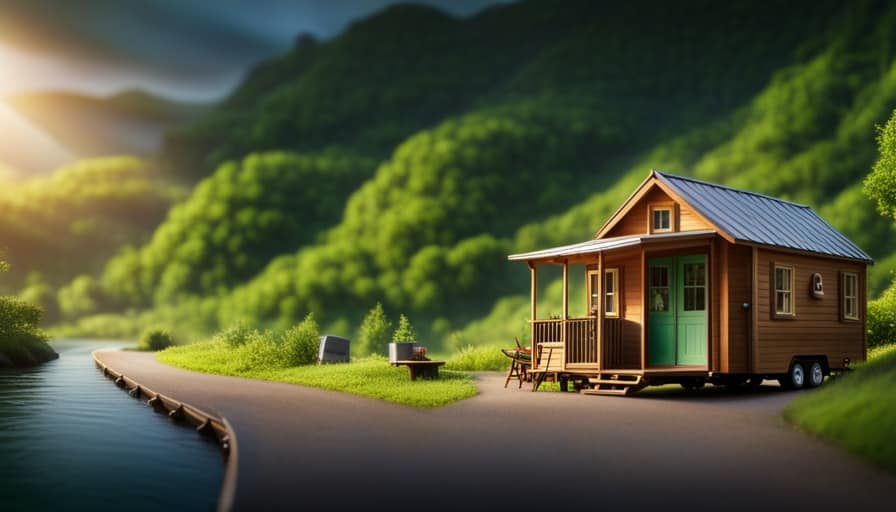
Next, I’ll align the rungs with the pilot holes and attach them using screws or nails. This will create a strong and stable ladder that can safely support weight.
Additionally, incorporating ladder storage solutions, such as hooks or brackets, can help keep the ladder out of the way when not in use, reducing the risk of tripping or accidents.
Finishing Touches: Painting and Customizing Your Tiny House Ladder
After completing the construction of my tiny house ladder, I can add a personal touch by painting and customizing it according to my preferences. Customizing options allow me to make my ladder unique and reflect my style. Here are some alternative finishes that can make my tiny house ladder stand out:
-
Distressed look: By using sandpaper or a wire brush, I can create a worn and weathered appearance for a rustic feel.

-
Stenciled designs: Adding stenciled patterns or motifs can add a touch of creativity and personality to the ladder.
-
Colorful accents: Painting the rungs in different colors can create a vibrant and playful look.
-
Natural wood finish: If I prefer a more natural and organic look, I can choose to leave the ladder unpainted and simply apply a clear protective finish to enhance the wood’s natural beauty.
Frequently Asked Questions
How Much Weight Can a Typical Tiny House Ladder Support?
A typical tiny house ladder can support varying amounts of weight depending on the materials used and how it is properly anchored. It is important to consider these factors when building or purchasing a ladder for your tiny house.

Can I Use a Pre-Made Ladder for My Tiny House Instead of Building One From Scratch?
Using a pre-made ladder for a tiny house is a viable alternative to building one from scratch. However, consider the pros and cons. Building allows customization, while buying offers convenience. Evaluate your needs and skills before deciding.
Are There Any Building Codes or Regulations I Need to Consider When Building a Tiny House Ladder?
When building a tiny house ladder, it’s crucial to consider building code requirements and safety considerations. Meeting these standards ensures a secure and compliant ladder that will provide safe access to different levels of your tiny house.
Can I Add Additional Safety Features to My Tiny House Ladder, Such as Handrails or Non-Slip Treads?
Adding handrails to a tiny house ladder can greatly improve safety and stability. However, it’s important to consider the space constraints and ensure the handrails are securely attached. Non-slip treads can also enhance traction and prevent accidents.
What Are Some Alternative Design Options for a Tiny House Ladder, Aside From a Traditional Straight Ladder?
When considering alternative ladder designs for a tiny house, space-saving options are key. Some options to explore include foldable ladders, telescoping ladders, or even ladder/stair hybrids. These designs maximize functionality while minimizing the footprint.

Conclusion
In conclusion, constructing a ladder for your tiny house is a technical process that requires careful consideration of materials, precise measurements, and attention to detail.
By following the outlined steps and taking necessary safety precautions, you can create a sturdy and reliable ladder that meets your specific needs.
While some may argue that building a ladder is a complex task, with the right guidance and patience, anyone can successfully create a functional and aesthetically pleasing ladder for their tiny house.
I’m Theodore, and I love tiny houses. In fact, I’m the author of Tiny House 43, a book about tiny houses that are also tree houses. I think they’re magical places where imaginations can run wild and adventures are just waiting to happen.
While tree houses are often associated with childhood, they can be the perfect adult retreat. They offer a cozy space to relax and unwind, surrounded by nature. And since they’re typically built on stilts or raised platforms, they offer stunning views that traditional homes simply can’t match.
If you’re looking for a unique and romantic getaway, a tree house tiny house might just be the perfect option.
-

 Beginners Guides2 weeks ago
Beginners Guides2 weeks agoHow To Buy A Tesla Tiny House
-

 Energy Efficiency1 month ago
Energy Efficiency1 month agoBest Tiny Homes For Cold Climates
-

 Beginners Guides1 week ago
Beginners Guides1 week agoTiny House Nation Where Are They Now Stephanie
-

 Tiny House Resources (e.g., legalities, cost, insurance, FAQs)2 months ago
Tiny House Resources (e.g., legalities, cost, insurance, FAQs)2 months agoDo Tiny Homes Need Planning Permission?
-

 Beginners Guides2 weeks ago
Beginners Guides2 weeks agoFrom The Show Tiny House Nation How Many Keep Their Tiny House?
-

 Beginners Guides2 months ago
Beginners Guides2 months agoUsing a Climbing Net For Treehouse Construction
-

 Beginners Guides2 months ago
Beginners Guides2 months agoHow to Build a Treehouse Without Drilling Into the Tree
-

 Beginners Guides3 weeks ago
Beginners Guides3 weeks agoTiny House Nation Who Pays For The Houses













